Fittings for sewage: what is the range and installation
Today, the use of metal, especially iron and steel in plumbing systems, is gradually being replaced by synthetics. Therefore, plastic fittings for sewage at the moment almost completely replaced the metal. There is no high pressure in the sewers, therefore, such transition elements are not made with flange connections, which significantly increases their installation speed. But the strength of the connection at the same time, due to rubber reductions, is not lost. We will tell you about what such adapters are and how they are mounted in a line, and also demonstrate the thematic video in this article.
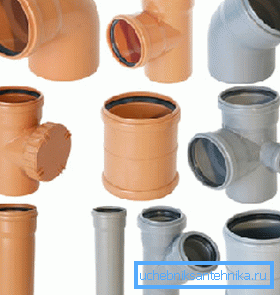
Fitting
Note. The word fitting comes from the English fit, which means to fit or mount, hence fiting. Such a connection takes place for arranging any pipelines (gas, liquid) and is used for turning, branching, docking, as well as for switching to a different diameter.
Configuration

- Corner fittings for plastic sewage pipes or, as plumbing angles are often called, can have different degrees of rotation, that is, can it be 90 ?, 45? or 32?. 90 of them are the most popular? and 45 ?, although from the 45-degree corners often make the same turn by 90 ?, which contributes to the smoothness of the transition and significantly reduces the likelihood of sewer blockages. For internal use, the diameter of such elements is 100 mm, 50 mm or 32 mm for a washing machine and dishwasher.
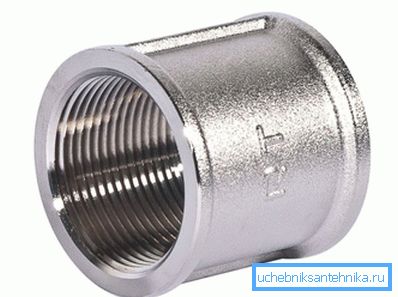
- Another simple transition is a coupling with two inlets for connecting unambiguous pipe ends - such connections are usually made when you need to insert a section of an installed sewage system, for example, to partially replace a riser in an apartment. Thanks to the coupling, you can use pipes where the seat cup is cut - such a connection for pipes with low pressure will be completely reliable and will never leak if there are no mechanical damages (the operating life here practically has no definite period). Very similar to the clutch for sewer systems a direct adapter, but it has a glass on one side only.
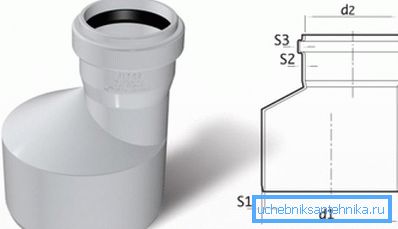
- For a direct transition from a pipe of 100 mm with a diameter of 50 mm, a plastic reduction is used, as in the photo above, which plumbing equipment is usually called a bottle.. Unlike a coupling, such a fitting can be used only if there is a glass at the inlet of the pipe.
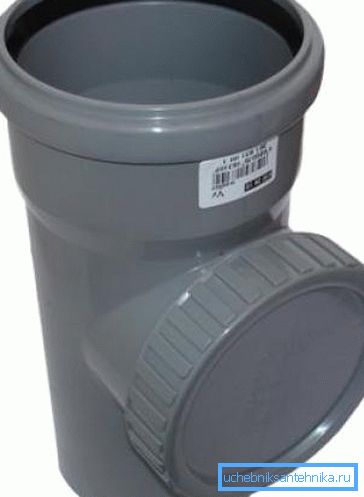
- The plastic revision is a regular tee with right angles and is sometimes used precisely for this, but if one tap is tapped, then this is already a place for the lid, unscrewing which you can clear the sewer. Such fittings are always on sale and they must be installed on the risers and long sections of sewage.

- And, of course, these are adapters where a complicated junction of knots is needed - tees, quadrangles, where can the rotation angles be 90 ?, 45? or 32 ?, moreover, the more difficult the outcome, the higher the price of the product. If we talk about fittings for domestic sewage, the main diameter here is 100 mm, but the outlets can be either 100 mm or 50 mm. It is noteworthy that all elbows can be not only with different inclinations, they also diverge in different directions relative to the direction of the main pipe.
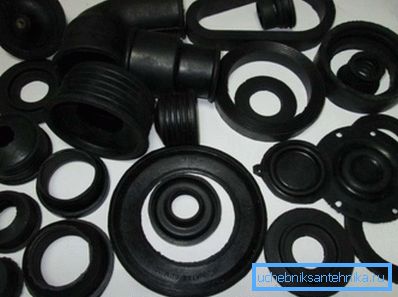
- It is noteworthy that pipes for washing and dishwashers 32 mm have their own fittings, but there is no plastic reduction from 50 mm to 32 mm - rubber reduction is always used here. Also, rubber is the main, I can even say the only seal to connect the various elements of the sewer. Silicone is used in some cases, but this means that the system has been assembled poorly — if everything is done correctly — there will be no leakage.
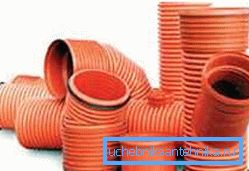
- Unlike internal, fittings for external sewage can be corrugated - this allows you to slightly change the angle of rotation when laying pipes in trenches. Also, there are no very difficult junctions where the outlets diverge not in the same plane, but along the entire perimeter, and the rest of the configuration of the elements coincides. It also does not use rubber reductions for transitions to a smaller diameter - only plastic with rubber seals, which is also a reduction.
Installation of sewage
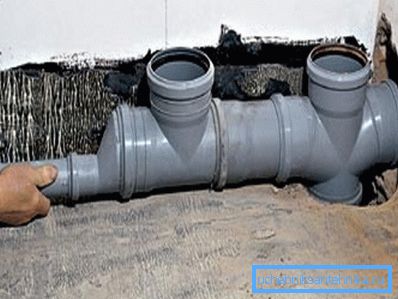
Due to the large range of fittings and the very different lengths of pipes, it is very easy to dilute sewers at all the right points, increasing or decreasing the distance between the inlets. In cases where the size of the pipes does not allow you to accurately adjust the distance, you can use a longer element by cutting off an unnecessary piece with a hacksaw. In case of need fixing plastic or metal arms are used.
Helpful advice. It happens that the rubber gasket is too rigid, and it is extremely difficult to dock - the gasket is skewed, and the instruction does not allow this (will leak). For easy docking, you can spread the end of the pipe with a liquid detergent - the connection will occur without any problems.
Conclusion
Before proceeding with the installation, you definitely need to mark all the sanitary facilities in order to purchase enough pipes and fittings for the sewage system. In addition, this marking will determine the number of fittings and their configuration.